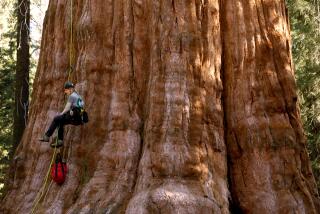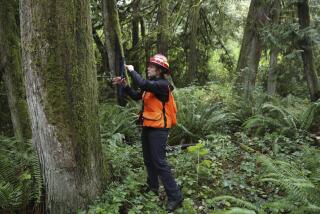Survivors of Insect, Storm Damage : Old Trees Show Natural Ups and Downs
PITTSBURG, N. H. â The hulking roots of a toppled tree, covered with moss and surrounded by saplings, symbolize life and death in one of North Americaâs last virgin stands of spruce and balsam fir.
The 110-acre stand, on the Connecticut River headwaters six miles from Canada, has been decimated by both nature and man in the last century. What is left, now owned by the Nature Conservancy, is in many places not a pretty sight.
Saved from logging operations but ravaged by a great hurricane in 1938 and by the spruce budworm in the early 1970s, the towering spruce trees, some estimated to be 350 years old, are few and far between.
âIt looks sad up there now after the budworm. It was so pretty before,â said Fred Cowan, a paper company forester who was instrumental in saving the stand at Norton Pool on East Inlet Brook.
The boggy lowlands are not ideal for spruce and fir. More impressive specimens can be found elsewhere, said Fredâs son, John. But at Norton Pool, he said, âthe idea is that they havenât been trashed.
Natural Regeneration
âYou can see what nature does to itself too. . . . It killed its own trees, and thereâs thick regeneration coming up. . . .â
The treesâ remote location--50 miles north of the last traffic signal in the state--also has helped to protect them since lumbering began in the area in the late 1800s.
The Connecticut Valley Lumber Co. bought the stand as part of 125,000 acres of timber in 1888, and loggers reached East Inlet 10 years later. The 10,000-acre East Inlet watershed had never been cut, but spruce was in demand.
The spring of 1898 was so dry, however, that logs could not be floated down to mills and railroads. After a few weeks, the crews gave up.
There was a budworm onslaught from about 1910 through 1915, though it wasnât nearly as serious as the later infestation of the 1970s. The tiny moth larvae eat the needles of spruce and fir, sometimes killing the trees.
In the hurricane of September, 1938, Fred Cowan estimates that at least 25% of the spruce and even more of the fir trees were blown down or broken. Cowan observed the destruction for the first time in 1941, when, at age 23, he was a member of the first St. Regis Paper Co. team survey to mark trees for cutting. St. Regis had bought Connecticut Valley Lumber in 1926.
Acres of Felled Trees
âSometimes we seemed to go a quarter of a mile climbing on top of blown-down trees. . . . Youâd be perhaps 10, 15, 20 feet in the air, climbing over that stuff.â The men realized that the trees still standing were special, he said. âMost of us hadnât been in large, old-growth stands before.â
St. Regis began cutting in East Inlet in the late 1940s, though not in the area now protected. By the 1950s, under increasing pressure to cut the oldest trees, Cowan and some colleagues began plotting how to spare them.
âSome of us kind of decided, âGee, you know, letâs kind of skip around that. We can always get back get to it.â Thatâs what we had to tell some of the other people in the company who said, âWhy did you bypass that?â â
Conservancy Acquisition
The Audubon Society and other conservation groups began expressing interest in saving the area, which also is home to some rare species of birds and plants. In the late 1960s, St. Regis agreed to save the stand, but it and Champion International Corp., which took over in 1984, for years refused to cede the land to conservationists. Champion deeded the area to the Nature Conservancy in July, 1987.
By then, nature had done more damage.
In 1974, masses of budworms swept into the region in a five-year infestation. âLots of places, very close to 100% of the fir got picked off, and a lot of the other growth, the small trees underneath,â Cowan said. âThe spruce was a little bit more resistant to it, but it got hit badly up there. It really spoiled the looks of it.â
More to Read
Sign up for The Wild
Weâll help you find the best places to hike, bike and run, as well as the perfect silent spots for meditation and yoga.
You may occasionally receive promotional content from the Los Angeles Times.






